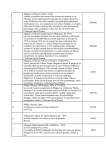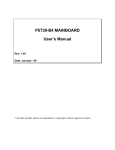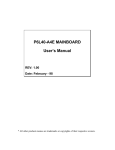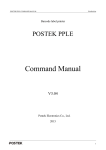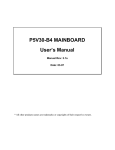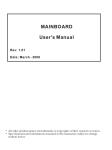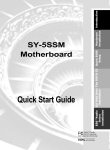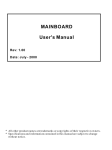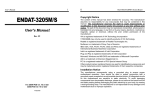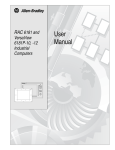Download MAINBOARD User`s Manual
Transcript
MAINBOARD User’s Manual (for board version 1.1 and later) Rev: 1.02 Date: December - 98 * All other product names are trademarks or copyrights of their respective owners. FCC & DoC Compliance Statement This device complies with Part 15 of the FCC rules, operation is subject to the following two conditions. 1. This device may not cause harmful interference and, 2. This device must accept any interference received, including interference that may cause undesired operation. This equipment has been tested and found to comply with limits for a Class B digital device, pursuant to Part 15 of the FCC rules. These limits are designed to provide reasonable protection against harmful interference in residential installations. This equipment generates, uses, and can radiate radio frequency energy, and if not installed and used in accordance with the instructions, may cause harmful interface to radio communications. However, there is no guarantee that interference will not occur in a particular installation. If this equipment does cause interference to radio or television equipment reception, which can be determined by turning the equipment off and on, the user is encouraged to try to correct the interference by one or more of the following measures: l Reorient or relocate the receiving antenna. l Move the equipment away from the receiver. l Plug the equipment into an outlet on a circuit different from that to which the receiver is connected. l Consult the dealer or an experienced radio/television technician for additional suggestions. The FCC requires the user to be notified that any change or modifications to the equipment by the user not expressly approved by the grantee or manufacturer could void the user’s authority to operate such equipment. The use of shielded cables for connection of the monitor to the graphics card is required to assure compliance with FCC regulations. 2 User’s Manual Table of Contents INTRODUCTION ...............................................................................5 Product Description ........................................................................................ 5 Item Checklist ................................................................................................ 5 Specifications ................................................................................................. 6 Board Level Feature........................................................................................ 7 Comprehensive Mainboard View.................................................................. 10 INSTALLATION ..............................................................................11 Installing the CPU ........................................................................................ 11 Setting the Jumpers ...................................................................................... 12 Connections.................................................................................................. 16 System Memory (DRAM SIMM/DIMMs)..................................................... 26 Installing an AGP Card ................................................................................ 28 MAINBOARD BIOS SETUP............................................................29 About the BIOS ............................................................................................ 29 Main Menu................................................................................................... 31 Standard CMOS Setup.................................................................................. 32 BIOS Features Setup..................................................................................... 36 Chipset Features Setup ................................................................................. 40 Power Management Setup ............................................................................ 43 PNP/PCI Configuration Setup....................................................................... 46 Load BIOS Defaults...................................................................................... 49 Load Setup Defaults...................................................................................... 49 Integrated Peripherals Setup ......................................................................... 49 Supervisor Password and User Password Setting........................................... 52 IDE HDD Auto Detection ............................................................................. 54 Save & Exit Setup / Exit Without Saving...................................................... 54 PCI Device Listing ....................................................................................... 55 User’s Manual 3 TABLE OF CONTENTS DESKTOP MANAGEMENT INTERFACE (DMI)..............................56 FLASH BIOS PROGRAMMING UTILITY ........................................57 HARDWARE MONITORING UTILITY .............................................59 APPENDIX A...................................................................................60 VIA MVP3 Driver Installation ..................................................................... 60 4 User’s Manual INTRODUCTION Product Description Designed as a flexible, high-performance and cost-effective solution for System Integrators and End Users alike, this mainboard provides the power and expandability to meet the requirements of the most advanced operating systems and software applications. This mainboard is designed to provide Pentium –based (FSB 100MHz) system by utilizing the VIA MVP3 AGPset on ATX AGP/PCI Platform. By incorporating such advanced features as Ultra DMA/33 Bus Mastering IDE and Universal Serial Bus (USB) onto the mainboard, optimum system performance is assured and system design and implementation is simplified. Fully “Plug & Play” compatible via an Award BIOS, this mainboard facilitates easy system configuration and peripheral setup. Advanced BIOS features include Temperature Monitoring and Alert functions designed to prevent the CPU from overheating. Also, the Award BIOS supports ACPI Readiness and is compatible with the PC’97 specification. With support for up to 512KB or 1MB Pipelined Burst SRAM L2 cache and 512MB of EDO or SDRAM System RAM, this mainboard is the ideal foundation for high-end computer systems. Item Checklist Your mainboard package should include the items listed below. Damaged or missing items should be reported to your vendor. þ The mainboard þ Floppy disk drive ribbon cable þ IDE ribbon cable þ Fan adaptive cable þ This User’s Manual þ CD-ROM containing VIA PCI Bridge driver, VIA VxD driver, VIA PCI Mini-port driver Bus Master IDE driver, support software for updating the FLASH BIOS and IDE drivers Trend ® PC-cillin Anti-Virus Software User’s Manual 5 INTRODUCTION Specifications Processor Chipset BIOS Cache Memory System Memory On-board I/O Features Advanced Features ZIF socket 7 support AMD K6 / K6-2 (FSB 100MHz) up to 400 MHz, CYRIX MII up to PR300, INTEL Pentium MMX up to 233 MHz, VIA MVP3 AGPset Award BIOS, support DMI, Green PC, Plug-and-Play, ACPI, Boot from CD-ROM, LS-120 120MB F.D.D.., ZIP Devices Support Symbios SCSI BIOS On board 512 KB /1 MB Write-back, Pipelined Burst L2 Cache 4×SIMM+2×DIMM MAX. 512MB Support SDRAM, EDO, FPM DRAM module 1×FDC Port ( LS120) 1×Parallel Port (EPP, ECP Port) 2×Serial Port (16550 Fast UART Compatible) 2×USB ports 1×IrDA TX/RX Header 1×Wake-On-LAN connector 1. Wake-up on LAN 2. Modem Ring-in Remote Power on 3. Hardware Monitoring (Fan, Temperature, Voltage) PCI Bus Master IDE 2×PCI Bus Master IDE Port UltraDMA/33 Mode up to 33MB/s transfer rate Power Connector Expansion Slots Form Factor ATX 20-pin Power Connector 6 1×32-bit AGP slot, 4×32-bit PCI Slots, 2×16-bit ISA Slots ATX Size ( 185mm x 305mm) User’s Manual INTRODUCTION Board Level Feature 1. 2. 3. 4. 5. 6. 7. 8. 9. 10. ISA slots 11. USB connectors Mainboard BIOS 12. PS/2 Mouse connector(top) PCI slots 13. PS/2 Keyboard connector(bottom) AGP slot 14. ATX power connector Infrared (IR) connector 15. CPU socket ( Socket 7) DRAM DIMM sockets 16. Floppy connector DRAM SIMM sockets 17. Secondary IDE connector COM2 connector 18. Primary IDE connector Printer port connector 19. Via MVP3 AGPset COM1 connector 20. Wake-up On LAN connector * Board Size: ATX Size : 185mm x 305mm User’s Manual 7 INTRODUCTION 1. ISA SLOTS: (2) 16-bit ISA slots. 2. MAINBOARD BIOS: Award BIOS supporting “Plug and Play”, DMI, Green PC specification, Enhanced IDE and Multi-I/O. The BIOS is FLASH Upgradeable via the AWDFLASH Utility. 3. PCI SLOTS: (4) 32-bit PCI slots are provided. 4. AGP SLOTS: (1) Accelerated Graphics Port for high performance graphics capabilities, especially 3D. 5. BACK INFRARED (IR) CONNECTOR: UART2 can also be used for the optional Infrared Module, enabling wireless communication capability. A supplied bracket with a single customized cable connects directly to the infrared pin-header on the mainboard 6. DRAM DIMM SOCKETS: (2) 168-pin DIMM sockets are provided to support a maximum RAM memory capacity of 512 MB.DIMM types 3.3V Extended Data Output (EDO) DRAMs and SDRAM. 7. DRAM SIMM SOCKETS: (4) 72-pin SIMM sockets are provided to support a maximum RAM memory capacity of 512 MB.DIMM types of either Fast Page Mode (FPM) or Extended Data Output (EDO) DRAM are supported and automatically detected by the BIOS. 8. COM2 CONNECTOR: High-speed UART compatible serial port. COM2 can be directed to the Infrared Module for wireless connection capability 9. PRINTER PORT CONNECTOR: EPP and ECP compatible parallel port. 10. COM1 CONNECTOR: High-speed UART compatible serial port. 11. USB CONNECTORS: These connectors permit the connection of two USB peripheral devices directly to the port without an external hub. USB is a new technology supporting keyboards, mouse, printers, fax modems and other telephony devices. 12. PS/2 MOUSE CONNECTOR: Supports PS/2 style mice 13. PS/2 KEYBOARD CONNECTOR: Supports PS/2 style keyboards. 14. ATX POWER CONNECTOR: 20-pin ATX Power Connector. 15. CPU SOCKET: ZIF Socket 7 mainboard supports CPU speeds up to 300MHz for AMD K6-2 (100MHz CPU), AMD K6 up to 300MHz and Cyrix MII CPU up to PR300, Intel Pentium CPU up to 233MHz. 16. FLOPPY CONNECTOR: Built-in floppy controller supports (2) 5.25" or 3.5" (1.44MB or 2.88MB) floppy drives. 17. SECONDARY IDE CONNECTOR: Connector for second IDE channel. 8 User’s Manual INTRODUCTION 18. PRIMARY IDE CONNECTOR: Connector for first IDE channel. The onboard PCI Bus Mastering IDE controller features support for DMA Mode 2, PIO Modes ¾, and Ultra DMA/33 (33MB/sec) for faster data transfer rates. (2) Connectors are provided for support of up to (4) IDE devices on two channels. Other ATAPI and Enhanced IDE devices such as Tape Drives and CD-ROMs are also supported. 19. CHIPSET: VIA MVP3 AGPset can support Socket 7 100MHZ CPUs. 20. Wake-up On LAN connector: The wake-up On LAN connector will allow the network to wake up a Soft Power Down(Soft-Off) PC. User’s Manual 9 INTRODUCTION Comprehensive Mainboard View 10 User’s Manual INSTALLATION Static Precautions Static electricity can be a serious danger to the electronic components on this mainboard. To avoid damage caused by electrostatic discharge, observe the following precautions: ü Don’t remove the mainboard from its anti-static packaging until you are ready to install it into a computer case. ü Before you handle the mainboard in any way, touch a grounded, anti-static surface, such as an unpainted portion of the system chassis, for a few seconds to discharge any builtup static electricity. ü Handle add-in cards and modules by the edges or mounting bracket. Installing the CPU ü WARNING: Use of a CPU Cooling Fan is required to prevent CPU from overheating. The Fan should be installed first before inserting the CPU into its socket. 1. Locate the ZIF (Zero Insertion Force) Socket 7. 2. First open the socket by pulling the lever sideways, then upwards. Notice how the lever locks in place when pressed all the way down. 3. The CPU must be inserted with the correct orientation. One corner of the CPU has a “Notch” and looks different that the other three. This corner is also missing a pin unlike other three and is marked with a white dot on top of the CPU. Align this corner towards the end of the lever as shown in the figure below. Insert the CPU, press it down, and close the lever until it locks into place. User’s Manual the 11 INSTALLATION Setting the Jumpers Jumpers are used on this mainboard to select various settings and features. A 2-pin jumper has two settings: Open and Short (or Closed). The jumper is closed by placing the Jumper Cap across the two pins, thereby connecting them. 3-pin jumpers can be set to pins 1-2 or 2-3 connected. Pin-1 is labeled on the circuit board. 3-pin Jumper 2-pin Jumper Pin 1-2 Open Pin 2-3 Short CPU Voltage Selection Jumper (JP13 and JP14) Locate Jumper blocks JP13 and JP14 on the mainboard. Set these jumper blocks in accordance with your specific CPU type. The Intel MMX CPU is an example of a dual supply chip (2.8V & 3.3V). When single supply CPUs are used, this setting is not relevant and should be left on the default. (Refer to the CPU documentation) 12 User’s Manual INSTALLATION • If you are uncertain about the speed or voltage requirements of your particular CPU, you should obtain Technical Documentation from the manufacturer. Such information is available via the Intel, Cyrix and AMD WWW sites. Refer to the following table for more CPU Vcore Voltage Selection jumper setting (JP14) : Vcore Jumper Setting Vcore 2.0V 2.7V 2.1V 2.8V 2.2V 2.9V 2.3V 3.0V 2.4V 3.1V 2.5V 3.2V Jumper Setting 2.6V CPU & SDRAM Clock Selection Jumper (JFS0-2, JCK1, JGP1-3 & JBF0-2) After installing the CPU, you must set the clock selection jumpers to match the frequency of the CPU. Find the Jumper Blocks labeled JFS0-2, JCK1, JGP1-3 and JBF0-2. Set the jumpers according to the illustration and table next page for your CPU frequency. Note: If you are using a CPU with 100MHz system bus, you must also set these jumpers according to your SDRAM specifications. Earlier SDRAMs may not support 100MHz. User’s Manual 13 INSTALLATION § This jumper automatically sets the ISA Clock as well. § The Internal (Core) frequency corresponds to the number marked on the CPU. The External Frequency when multiplied with the Ratio gives the CPU's internal frequency. Jumper setting for CPU: CPU Model CPU Clock Ratio (JBF0-2) 400MHz 350MHz 300MHz 250MHz Bus Clock (JFS0-2, JCK1, JGP1-3) 100MHz 100MHz 100MHz 100MHz AMD-K6-2-400MHz AMD-K6-2-350MHz AMD-K6-2-300MHz AMD-K6-2-266MHz AMD-K6-2-380MHz AMD-K6-2-333MHz 380MHz 333MHz 95MHz 95MHz ×4.0 ×3.5 AMD-K6-300MHz AMD-K6-266MHz 300MHz 266MHz 66MHz 66MHz ×4.5 ×4.0 14 User’s Manual ×4.0 ×3.5 ×3.0 ×2.5 INSTALLATION AMD-K6-233MHz AMD-K6-200MHz AMD-K6-166MHz AMD-K5-PR200 AMD-K5-PR166 AMD-K5-PR133 233MHz 200MHz 166MHz 66MHz 66MHz 66MHz 66MHz 66MHz 66MHz x3.5 x3.0 x2.5 x3.0 x2.5 ×1.5 Intel Pentium MMX-233 Intel Pentium MMX-200 Intel Pentium MMX-166 Intel Pentium MMX-150 Intel Pentium -200 Intel Pentium -166 Intel Pentium -150 Intel Pentium -133 Intel Pentium -120 233MHz 200MHz 166MHz 150MHz 200MHz 166MHz 150MHz 133MHz 120MHz 66MHz 66MHz 66MHz 60MHz 66MHz 66MHz 60MHz 66MHz 60MHz x3.5 x3.0 x2.5 x2.5 ×3.0 ×2.5 ×2.5 ×2.0 ×2.5 Cyrix MII PR333 Cyrix MII PR300 Cyrix MII PR266 Cyrix 6x86MX PR233 (M2) Cyrix 6x86MX PR200 (M2) Cyrix 6x86MX PR200 (M2) Cyrix 6x86MX PR166 (M2) Cyrix 6x86MX PR166 (M2) Cyrix 6x86 P200+ Cyrix 6x86 P166+ Cyrix 6x86 P150+ 333MHz 300MHz 266MHz 233MHz 150MHz 166MHz 133MHz 150MHz 150MHz 133MHz 120MHz 83MHz 66MHz 83MHz 75MHz 75MHz 66MHz 66MHz 60MHz 75MHz 66MHz 60MHz ×3.0 ×3.5 ×2.5 x2.5 x2.0 x2.5 x2.0 x2.5 x2.0 x2.0 x2.0 IDT C6-200 IDT C6-180 IDT C6-150 200MHz 180MHz 150MHz 66MHz 60MHz 75MHz ×3.0 ×3.0 x2.0 User’s Manual 15 INSTALLATION Connections CPU Cooling Fan (JP12) This mainboard features a fan monitoring function to alert you when the cooling fan starts to malfunction. If you are using a fan with the standard 4-pin MolexType Power-Supply connector, you should use the fan adaptive cable provided Plug the Molex-Type connector of the adaptive cable to the fan’s power connector and plug the other 3-pin Header Connector to JP12, regardless of the polarity. If your Fan provides this 3-pin Header Connector, simply plug it into JP12. 16 User’s Manual INSTALLATION IDE Activity LED (JP10) Hook the IDE LED lead to this jumper, with the RED lead corresponding to Pin1. Soft Power Switch (JP9) Connects to the Power Switch featured on ATX case design. This switch must be hooked up before the system can be powered on, unlike the traditional “Baby-AT” designs where the power switch is located on the power supply itself. Note: Under the following two conditions, you have to press and hold the switch for longer than 4 seconds to power off your system, regardless of the “Soft-Off by PWRBTN” setting in the Power Management Setup of the BIOS (page 43 ). • • Shortly after the system is powered on, when the BIOS message is not yet appear. When CPU hangs. User’s Manual 17 INSTALLATION Power Supply Connector This mainboard features an ATX Power Connector. This connector is keyed to prevent connection in the wrong direction. Line up the locking mechanism on the connector from the ATX Power Supply with the tab on the mainboard connector. Press down until the two connectors are locked. 18 User’s Manual INSTALLATION System Functions Jumper Block (J19) Pins [3 & 5] Turbo LED switch - The Turbo function is not supported by this mainboard. Therefore, the Turbo LED will always remain lit as long as the system power is on. Pins [17 & 19] Reset switch lead - Connects to the Reset Switch lead from the system case. The reset switch is used to “Cold-boot” the system without actually turning off the power, reducing wear and tear on the power supply. Pins [2, 6, 8, 10] Keyboard lock switch lead - Pins 2 & 6 connect to the Power LED from the system case. Pins 8 & 10 connect to the case-mounted keylock switch. Pins [14 & 20] Speaker connector - Connects to the Speaker lead from the system case. User’s Manual 19 INSTALLATION Wake-On-LAN Connector (JP11) The Wake-On-LAN function will allow the network to power on a system or return it to full power out of suspend mode. To use the Wake-On-LAN function, you must enable the “Modem-Ring/LAN Resume” field in the Power Management Setup of the BIOS (page 43). Connect the cable that comes with your LAN card to this connector. Refer to the add-in card’s manual for details. Note: Your LAN card must support Magic Packet in order to use the Wake-OnLAN function. 20 User’s Manual INSTALLATION USB Connector This 8-pin connector permits connection of two USB peripheral devices directly to the system without an external hub. USB PS/2 Keyboard and Mouse Connectors These two connectors are located on the back panel of the mainboard. PS/2 Mouse PS/2 Keyboard User’s Manual 21 INSTALLATION Serial and Parallel Ports A 25-pin D-Sub header is provided on the back panel for a multi-mode bidirectional parallel port. Two 9-pin D-Sub headers are also provided on the back panel for Serial ports. * Modem Ring-In Power On Install a modem (normally to COM2) and enable Power on by Ring/LAN function from BIOS setup. (Please refer to page 43). This allows the modem to remotely power on the system or return it to full power out of suspend/standby mode. Parallel Port COM 1 22 User’s Manual COM2 INSTALLATION IrDA-compliant infrared module connector The IrDA connector bracket hooks directly to this connector on the mainboard. This connector provides support for the optional wireless transmitting and receiving infrared module. You must first configure through “UART2 Mode” in INTEGRATED PERIPHERALS SETUP where UART2 is directed, COM2 or IrDA. User’s Manual 23 INSTALLATION Floppy drives The on-board floppy controller supports (2) floppy disk drives with the floppy ribbon cable provided. Make sure the RED stripe on the ribbon cable is oriented towards Pin-1. Notice the “twist” between the sets of connectors on the floppy cable. The floppy drive “A” position is at the END of the cable, whereas floppy drive “B” is hooked to one of the connectors on the other side of the twist. The cable provides both “Edge” and “Pin” connectors for both the A and B positions to match the connector on your floppy drives. 24 User’s Manual INSTALLATION IDE Hard Drives and CD-ROMs The on-board Enhanced IDE controller can support up to (4) IDE hard drives or other ATAPI devices, such as CD-ROMs. This controller, as with all Enhanced IDE controllers, consists of both Primary and Secondary ports. Each port has an associated connector and cable which can support up to (2) ATAPI devices each. All IDE devices have jumpers which allow the user to configure the device as either “Master” or “Slave”. A Master device is one that is ALONE on the IDE cable, whereas a Slave device is installed as a SECOND device on the same cable. Keep in mind that the Master device will appear before the Slave device in the CMOS Setup, as well as the Operating System software. *Refer to the device documentation for jumper settings. The Secondary IDE port can be used for up to (2) additional ATAPI devices. Normally it’s recommended that you connect your first hard drive to the Primary port, and the first CD-ROM to the Secondary. Make sure to align the RED stripe on the ribbon cable with Pin-1 on the mainboard IDE connector. On most hard drives and CD-ROMs, the RED stripe should be oriented towards the power connector of the device. User’s Manual 25 INSTALLATION System Memory (DRAM SIMM/DIMMs) • This mainboard supports 72-pin SIMMs and 168-pin DIMMs of two types: • SIMM: 5 Volt Fast Page Mode (Asymmetric or Symmetric) or EDO (Extended Data Output) • DIMM: 3.3 Volt unbuffered SDRAM (Synchronous Dynamic Random Access Memory) or 3.3 Volt EDO. • To ensure reliability, it is recommended to use PC100 SDRAM for your 100 MHz clocked SDRAM performance requirement. • SIMM Sizes supported: 4MB, 8MB, 16MB, 32MB, 64MB, and 128MB • DIMM Sizes supported: 8MB, 16MB, 32MB, 64MB, and 128MB • A total of (4) SIMMs or (2) DIMMs can be installed for a maximum RAM capacity of 256MB. Do not mix both SIMM and DIMM modules on the same mainboard. • Minimum RAM capacity is 8MB (With (2) 4MB SIMMs Installed or (1) 8MB DIMM) • SIMM/DIMMs speed requirements: 70ns or 60ns • This mainboard contains (2) SIMM Banks and (2) DIMM Banks. The SIMM banks consists of (4) SIMM Sockets. For SIMMs, memory must be installed two SIMMs at a time. Both SIMMs in a bank must be identical. DIMM modules, on the other hand, can be installed one at a time. 26 User’s Manual INSTALLATION Installing a SIMM The module must be oriented in the correct way. There is a notch in one end of the SIMM. Align this notch as shown in the diagram below. Slip a SIMM at a 45° angle into a socket. Gently push the SIMM to the upright position until the retainers on both sides of the socket lock the module in place. To remove a SIMM, push the retainers outwards to release the module then pull the module out of the socket. Installing a DIMM The modules must be oriented in the correct way. Notice the notches of the DIMM. Align these notches as shown in the diagram below. Firmly push the DIMM until the retainers on both sides of the socket lock the module in place. To remove a DIMM, push the retainers outwards to release the module then pull the module out of the socket. 1 notch 1 DIMM 1 1 DIMM 2 User’s Manual notch 27 INSTALLATION The Level-2 Cache (SRAM) Two cache sizes are available: • 512KB Cache: (1) 64Kx64 512K SRAM chips • 1MB Cache: (2) 64Kx64 512K SRAM chips The Level-2 Cache on this mainboard is not upgradeable. Installing an AGP Card This mainboard provides an AGP slot to support a new generation of graphics cards with high performance graphics capability. Note 1: Make sure that the AGP card is firmly seated in the AGP slot. For the card that complies with the AGP 1.x specifications, a slightly more force may be required to fully insert the card into the slot. For cards that comply with AGP 2.0 and later specifications, the installation should be relatively easy. Note 2: Before installing the AGP drivers under Windows 95/98, specific software support must be included in your system first. For detailed driver installation procedure, please refer to Appendix A. 28 User’s Manual MAINBOARD BIOS SETUP About the BIOS The Mainboard BIOS (Basic Input/Output System) acts as the bridge between your Hardware (CPU, Disk Drives, Video, etc.) and Operating System Software (Windows 95, OS/2 and so on…) The BIOS Setup (also called CMOS Setup) is where many hardware configuration options are set and stored. This configuration information will remain in the BIOS until it is changed, or cleared by removing the battery for a while and then putting it back. CMOS (Complementary Metal Oxide Semiconductor) refers to the chip in which the BIOS information is stored. This mainboard features Award BIOS, which provides an easy to use Setup program to aid in hardware configuration. In this section we will look at the various menus and options contained in the Award BIOS Setup Program. This mainboard also features a “Flash” BIOS. A Flash BIOS can be upgraded via software, thereby eliminating the need to actually replace the “BIOS Chip” on the mainboard. Procedures for updating the BIOS follow this section. The Award BIOS installed in your computer system’s ROM (Read Only Memory) is a custom version of an industry standard BIOS. This means that it supports Intel/Cyrix/AMD processors in a standard IBM-AT compatible input/output system. Using Setup In general, you use the arrow keys to highlight items, press <Enter> to select, use the PageUp and PageDown keys to change entries, press <F1> for help and press <Esc> to quit. Getting Help Pressing F1 will display a small help window that describes the appropriate keys to use and the possible selections for the highlighted item. To exit the Help Window press <Esc>. User’s Manual 29 MAINBOARD BIOS SETUP A Final Note about Setup Not all systems have the same Setup. While the basic look and function of the Setup program remains the same for all systems, individual motherboard and chipset combinations require custom configurations. For example, you may find that your Setup main menu has a different number of entries from the main menu displayed in this manual. These are simply features not supported (or not user configurable) on your system. The final appearance of the Setup program also depends on the Original Equipment Manufacturer (OEM) who built your system. If your OEM has decided that certain items should only be available to their technicians, those items may very well be removed from the Setup program. • Shortly after the system is powered on, provided a CPU and sufficient RAM are installed, you will see the message: Press DEL to enter SETUP. • Press the DEL key to enter the Award BIOS Setup program. 30 User’s Manual MAINBOARD BIOS SETUP Main Menu Once you enter the Award BIOS CMOS Setup Utility, the Main Menu will appear on the screen. The Main Menu allows you to select from several setup functions and two exit choices. Use the arrow keys to select among the items and press <Enter> to accept and enter the sub-menu. ROM PCI/ISA BIOS (xxxxxxxx) CMOS SETUP UTILITY AWARD SOFTWARE, INC. STANDARD CMOS SETUP INTEGRATED PERIPHERALS BIOS FEATURES SETUP SUPERVISOR PASSWORD CHIPSET FEATURES SETUP USER PASSWORD POWER MANAGEMENT SETUP IDE HDD AUTO DETECTION PNP / PCI CONFIGURATION SAVE & EXIT SETUP LOAD BIOS DEFAULTS EXIT WITHOUT SAVING LOAD SETUP DEFAULTS ↑ ↓ → ← : Select Item (Shift) F2 : Change Color Esc : Quit F10 : Save & Exit Setup Time, Date, Hard Disk Type … Note that a brief description of each highlighted selection appears at the bottom of the screen. User’s Manual 31 MAINBOARD BIOS SETUP Standard CMOS Setup This first menu is where the most basic hardware options are set. Information regarding the system clock, IDE hard disks and floppy drives is stored and configured in this section. To enter the Standard CMOS Setup, press the [ENTER] key with this menu highlighted. Upon entering the Standard CMOS Setup screen, you will see a screen like that below. Date (mm:dd:yy) : Fri, Apr 7 1998 Time(hh:mm:ss) : 00:00:00 HARD DISKS Primary Master Primary Slave Secondary Master Secondary Slave : : : : TYPE SIZE CYLS HEAD PRECOMP LANDZ SECTOR MODE Auto 0 0 0 0 0 0 Auto Auto 0 0 0 0 0 0 Auto Auto 0 0 0 0 0 0 Auto Auto 0 0 0 0 0 0 Auto Drive A : 1.44M , 3.5in. Drive B : None Floppy 3 Mode Support: Disabled Base Memory Extended Memory : 640K : 15360K Video : EGA / VGA Other Memory : Halt On : All Errors Total Memory : 16384K ESC : Quit F1 : Help ↑ ↓ → ← : Select Item (Shift) F2 : Change Color 384K PU / PD / + / - : Modify First, let’s set the system Date. Use the arrow keys to move to and highlight the “Date” option. Select the Month by using the PgDn and PgUp keys. This is how most settings will be configured. Then, move to the day, year and time via the arrow keys to finish setting the system date and time. Keep in mind that the system time is set in 24-hour time. With this method, 1PM is represented as 13:00, 2PM as 14:00 and so on, with 00:00 corresponding to Midnight. Pri Master, Pri Slave, Sec Master, Sec Slave - These four options relate to the (4) IDE hard drives, CD-ROMs or other ATAPI devices that can be controlled via the on-board IDE controller (review IDE Hard Drives and CD-ROMs on page 25). The “Pri Master” setting specifies the first device on the primary IDE channel, “Pri Slave” - the second. Sec Master and Sec Slave specify the devices on the secondary channel. 32 User’s Manual MAINBOARD BIOS SETUP The first option available is the most important: Type. This is where you will specify the type of device and how it is represented in the BIOS Setup. If the device is a hard disk or CD-ROM, generally the Auto option is the best choice for fast and easy setup of the hard disk parameters. Here’s an explanation of the Auto and User options: • Auto - This option instructs the BIOS to automatically configure the hard disk by reading the parameters (cylinders, sectors, etc.) directly from the hard disk firmware. Use this option if you are configuring a new hard drive, or one that has already been formatted using the Auto option. Keep in mind that a hard drive is configured using a certain set of parameters, those same parameters must be used for the life of the drive, unless the drive is re-FDISKed using a different parameter set. (This procedure deletes the old partition(s) on the drive and creates a new one, using the new parameters). • User - This option allows you to CYLS. HEADS manually enter in the parameters of the PRECOMP hard drive. Generally, this option would LANDZONE be used only if the hard drive has already SECTORS been formatted with a certain set of MODE parameters, and assured consistency between the old and new parameters is desired. TYPE drive type number of cylinders number of heads write precom landing zone number of sectors mode type Mode - One of Enhanced IDE’s most important features is LBA (Logical Block Addressing) Mode. This feature allows the use of larger hard drives by providing a way to bypass the cylinder limitations imposed by many Operating Systems. LBA Mode is used to extend a hard drive’s useable capacity by “remapping” the cylinders in a way that is acceptable to these operating systems. For instance, a hard drive with the parameters of 2100 Cylinders, 16 Heads and 63 Sectors would be represented by LBA Mode as 525 Cylinders, 64 Heads and 63 Sectors. (Notice that the Cylinders have been divided, and the Heads have been multiplied, by a factor of 4.) On hard drives smaller in capacity than 528MB, LBA support is not needed. The option on these devices is ignored, even if enabled. For hard drives greater than 528MB, LBA mode should be enabled. The following rules apply: • Operating Systems that do not use the FAT file system do not need LBA Mode, and can use the Normal or Large Modes. Examples would be Netware and Unix. User’s Manual 33 MAINBOARD BIOS SETUP • When configuring a new hard drive greater than 528MB in capacity, always make sure LBA mode is enabled. If you are using a hard drive that is over 528MB in capacity, but was already formatted without using LBA mode, LBA support will be ignored even if it is enabled. This assures correct access to the drive’s data. SCSI Hard Drives are NOT entered into the Mainboard BIOS Setup in any way. The hard drive settings in the Standard CMOS Setup are only for drives connected to the IDE Controller. So, if only SCSI drives were installed, all these settings would be set to Type: None. SCSI Devices are configured via the SCSI controller’s BIOS. • • Floppy Drives A: and B: - Select the Type for the A: and/or B: floppy drives. Remember, floppy drive A: is the first drive, hooked to the END of the floppy ribbon cable. Floppy drive B: is hooked up after the twist. Available settings are listed below: None 360K, 5.25 in 1.2M, 5.25 in 720K, 3.5 in 1.44M, 3.5 in 2.88M, 3.5 in No floppy drive installed 5-1/4 inch PC-type standard drive; 360 kilobyte capacity 5-1/4 inch AT-type high-density drive; 1.2 megabyte capacity 3-1/2 inch double-sided drive; 720 kilobyte capacity 3-1/2 inch double-sided drive; 1.44 megabyte capacity 3-1/2 inch double-sided drive; 2.88 megabyte capacity Floppy 3 Mode Support: - Enable this option ONLY for floppy drive(s) that support the Japanese standard (1.2MB on 3.5” Diskette). Options: Disabled (Default), Both, Drive A / B. Video - This category selects the type of video adapter used for the primary system monitor. Although secondary monitors are supported, you do not have to select their type in Setup. EGA/VGA CGA 40 CGA 80 MONO Enhanced Graphics Adapter/Video Graphics Array. For EGA, VGA, SEGA, SVGA or PGA monitor adapters. Color Graphics Adapter, power up in 40 column mode Color Graphics Adapter, power up in 80 column mode Monochrome adapter, includes high resolution monochrome adapters Halt On - Determines if the system will prompt you if an error is detected during POST. 34 User’s Manual MAINBOARD BIOS SETUP No errors All errors All,But Keyboard All, But Diskette All, But Disk/Key The system boot will not be stopped for any error that may be detected. Whenever the BIOS detects a non-fatal error the system will be stopped and you will be prompted. The system boot will not stop for a keyboard error; it will stop for all other errors. The system boot will not stop for a disk error; it will stop for all other errors. The system boot will not stop for a keyboard or disk error; it will stop for all other errors. Memory - This category is display-only. All memory detected by the POST (Power On Self Test) of the BIOS is shown as the following types: Base Memory is the amount of conventional memory installed in the system. This value is typically 640K for systems with 640K or more memory installed on the motherboard. The Extended Memory is the amount of memory located above 1MB in the CPU's memory address map. Other Memory refers to the memory located in the region between 640K and 1MB. This region can be used for shadowing as well as expanded memory in DOS. User’s Manual 35 MAINBOARD BIOS SETUP BIOS Features Setup This menu provides access to more advanced BIOS configuration settings that deal with overall performance of the system and peripheral setup. This section allows you to configure your system for basic operation. You have the opportunity to select the system’s default speed, boot-up sequence, keyboard operation, shadowing and security. Anti-Virus Protection CPU Internal Cache External Cache Quick Power On Self Test Hard Disk Boot From Boot Sequence Swap Floppy Drive Boot Up Floppy Seek Boot Up NumLock Status Gate A20 Option Memory Parity/ECC Check Typematic Rate Setting Typematic Rate (Chars/Sec) Typematic Delay (Msec) Security Option PCI / VGA Palette Snoop OS Select For DRAM > 64MB HDD S.M.A.R.T. Capability Report No FDD For WIN 95 : Enabled : Enabled : Enabled : Disabled : Pri-IDE-M : C, A : Disabled : Enabled : On : Fast : Disabled : Disabled :6 : 250 : System : Disabled : Non-OS2 : Disabled : No Video BIOS Shadow C8000-CBFFF Shadow CC000-CFFFF Shadow D0000-D3FFF Shadow D4000-D7FFF Shadow D8000-DBFFF Shadow DC000-DFFFF Shadow ESC : F1 : F5 : F6 : F7 : : Enabled : Disabled : Disabled : Disabled : Disabled : Disabled : Disabled Quit ↑ ↓ → ←: Select Item Help PU/PD/+/- : Modify Old Values (Shift) F2 : Color Load BIOS Defaults Load Setup Defaults Anti-Virus Protection – Enables/Disables the built-in anti-virus for protection against boot virus infection. Unlike traditional BIOS protection which generally consists of simply write protecting the hard disk partition table, this Anti-Virus protection provides more complete virus protection by taking control early in the boot process, detecting boot viruses before they have a chance to load. 36 User’s Manual MAINBOARD BIOS SETUP CPU Internal Cache - Enables or Disables the Level-1 Internal Cache memory. Generally, this would only be Disabled for troubleshooting purposes. External Cache - Enables or Disables the Level-2 External Cache memory. Generally, this would only be Disabled for troubleshooting purposes. Quick Power on Self Test - Speeds up Power On Self Test (POST) after the computer is powered on. When set to Enable, the BIOS will shorten or skip some checks during POST. Hard Disk Boot From - This option lets you choose to boot from Primary IDE Master (Pri-IDE-M), Primary IDE Slave (Pri-IDE-S), Secondary IDE Master (SecIDE-M), Secondary IDE Slave (Sec-IDE-S) or SCSI hard disk. Same as IDE options, the Boot Sequence in the next field is set to C, A when the SCSI is chosen. Boot Sequence - When your system is powered on, the BIOS performs a variety of operations, then attempts to boot an Operating System from either a hard drive, floppy drive, CD-ROM or LS-120/ZIP. This setting determines the sequence that the BIOS will follow when searching devices for a bootable disk. Most users find the C, A setting to be most beneficial, since it takes the least amount of time to boot the system. If however, you want the ability to boot from a Floppy or CDROM drive, you would need to choose either the A, C or CDROM, C, A setting. For instance, if your boot sequence was set to C, A and for some reason you wanted to boot to your Floppy A: Drive, it would not be possible, since the BIOS would always boot from the C: drive first. In this case, this setting would need to be changed to A, C so that the system would first check the floppy drive for a bootable disk. This would slow bootup speed, however, since the floppy would be checked on every boot. A,C C, A C, CDROM, A CDROM, C, A C only LS/ZIP, C System will first search for boot sector on floppy disk, then hard disk. System will first search hard disk drive then floppy disk drive for boot sector. System will first search for boot sector on hard disk drive , then CDROM drive, and then floppy disk drive. System will first search the CDROM drive, then hard disk drive and then floppy disk drive for boot sector. System will search for boot sector on hard disk drive only. System will first search for boot sector on LS-120 IDE floppy drive or ZIP ATAPI drive, then hard disk. User’s Manual 37 MAINBOARD BIOS SETUP Swap Floppy Drive - The hardware connections determine which floppy is configured as drive A: and drive B: “Swapping” the floppy drives can be useful if your system has two floppy drives, and you want the ability to boot from both. For example: Since a PC cannot boot from the B: Floppy, you would need to “Swap” floppy drives A: and B: in order to set the second floppy drive to drive A:, thereby making it bootable. Boot Up Floppy Seek - When enabled, BIOS will attempt to move the head of the floppy disk drive forth and back once during POST to see if the drive is working properly. Boot Up NumLock Status - When On, the NumLock key will be automatically enabled when the system boots. Gate A20 Option - This entry allows you to select how the gate A20 is handled. The gate A20 is a device used to address memory above 1 Mbytes. Initially, the gate A20 was handled via a pin on the keyboard (Normal). Today, while keyboards still provide this support, it is more common, and much faster, for the system chipset (Fast; default) to provide support for gate A20. Memory Parity/ECC Check - When Disabled (Default), there will be no memory errors shown on the monitor for Memory parity SERR# (NMI). When parity DRAM modules are used, select Parity or ECC (Error Checking and Correcting) to correct 1 bit memory errors in the memory. Typematic Rate Setting - Determines if the typematic rate is to be used. When disabled, continually holding down a key on your keyboard will generate only one instance. In other words, the BIOS will only report that the key is down. When the typematic rate is enabled, the BIOS will report as before, but it will then wait a moment, and, if the key is still down, it will begin to report that the key has been depressed repeatedly. This feature is used to accelerate cursor movements with the arrow keys. Typematic Rate (Chars/Sec) - When the typematic rate is enabled, this selection allows you to select the rate at which the keys are accelerated: Options are 6 (default), 8, 10, 12, 15, 20, 24 and 30. Typematic Delay (Msec) - When the typematic rate is enabled, this selection allows you to select the delay (in msec) between when the key was first depressed and when the acceleration begins. Options are 250 (default), 500, 750 and 1000. 38 User’s Manual MAINBOARD BIOS SETUP Security Option - This option enables password checking every time the computer is powered on or every time BIOS Setup is executed. If System is chosen, a user password prompt appears every time the computer is turned on. If Setup is chosen, the password prompt appears only when the BIOS Setup program is executed. Refer to the section Supervisor Password for more information. PCI / VGA Palette Snoop - This option must be set to Enabled if any ISA MPEG card installed requires VGA palette snooping. The settings are Disabled or Enabled. OS Select For DRAM > 64MB - This should be set to OS2 if you are running IBM OS/2 with more than 64MB of RAM in the system. Otherwise, the setting should be Non-OS2. HDD S.M.A.R.T. Capability - Enables/disables Self-Monitoring Analysis and Reporting Technology, by which HDD within a computer can communicate it’s predicted reliability status to its user and system administrator to provide comprehensive protection that can prevent system downtime and even the loss of valuable data. Report No FDD For WIN 95 - With the FDD in “STANDARD CMOS SETUP” set to NONE, set this option to Yes to release IRQ6 for passing Win95 logo. This option is irrelevant under normal operation. Video BIOS Shadow - This option controls the location of the contents of the 32KB of Video ROM beginning at the C0000h memory location. The settings are: Enabled Disabled The contents of C0000h-C7FFFh are written to the same address in system memory (RAM) for faster execution. The video ROM is not copied to RAM. The contents of the video ROM cannot be read from or written to cache memory. C8000-DFFFF Shadow - These options control the location of the contents of the 16KB expansion card ROMs beginning at the specified memory location. If no adapter ROM is using the named ROM area, this area is made available to the local bus. Shadowing a ROM reduces the memory available between 640KB and 1024KB by the amount used for this purpose. The settings are Enabled or Disabled. User’s Manual 39 MAINBOARD BIOS SETUP Chipset Features Setup This section allows you to configure the system based on the specific features of the installed chipset. This chipset manages bus speeds and access to system memory resources, such as DRAM and the external cache. It also coordinates communications between the conventional ISA bus and the PCI bus. It must be stated that these items should never need to be altered. The default settings have been chosen because they provide the best operating conditions for your system. The only time you might consider making any changes would be if you discovered that data was being lost while using your system. Bank 0/1 DRAM Timing Bank 2/3 DRAM Timing Bank 4/5 DRAM Timing SDRAM Cycle Length DRAM Read Pipeline Sustained 3T Write Cache Rd+CPU Wt Pipeline Cache Timing Video BIOS Cacheable System BIOS Cacheable Memory Hole At 15M-16M AGP Aperture Size AGP-2X Mode : FP/EDO 70 ns : FP/EDO 70 ns : FP/EDO 70 ns OnChip USB USB Keyboard Support : Enabled : Disabled :3 Slot 1 Use IRQ No. Slot 2 Use IRQ No. Slot 3 Use IRQ No. Slot 4 Use IRQ No. : Auto : Auto : Auto : Auto ** System Hardware Monitor ** CPU Overheat Alarm (> 72 °C) CPU Fan Malfunction Alarm System 5V Alarm (< 4.7V) : Disabled : Disabled : Disabled : Enabled : Enabled : Enabled : Fast : Enabled : Enabled : Disabled : 256M : Disabled ESC : F1 : F5 : F6 : F7 : Quit ↑ ↓ → ←: Select Item Help PU/PD/+/- : Modify Old Values (Shift) F2 : Color Load BIOS Defaults Load Setup Defaults Bank 0/1, 2/3, 4/5 DRAM Timing – FP/EDO DRAM timing is controlled by the DRAM timing registers. The timings programmed into this register are dependent on the system design. 60ns is the fastest rate. The 70ns timing is slower and may be required in certain system designs to support loose layouts or slower memory. Options are Turbo, Fast, Medium, Normal, FP/EDO 60 ns, FP/EDO 70 ns (default). SDRAM Cycle Length - This item allows you to set the SDRAM Latency Timer. Options are 2, 3 (default). 40 User’s Manual MAINBOARD BIOS SETUP DRAM Read Pipeline - This item allows you to enable/disable the read pipeline. Options are Disabled, Enabled (default). Sustained 3T Write – This item allows you to enable or disable direct map write back / write through secondary cache. Cache Rd+CPU Wt Pipeline - This item allows you to enable/disable the cache timing. Options are Disabled, Enabled (default). Cache Timing - This item determines the SRAM timing. Options are Fast (default) and Fastest. Video BIOS Cacheable - When Enabled, the Video BIOS cacheable will cause access to the video BIOS addressed at C0000H to C7FFFH to be cached. *Enabled is the default. System BIOS Cacheable - When Enabled, the Video BIOS cacheable will cause access to the System BIOS addressed at F0000H to FFFFFH to be cached. *Enabled is the default. Memory Hole At 15M-16M - In order to improve compatibility, certain space in memory can be reserved for old style ISA cards that map memory between 15M16M. Do not enable this feature unless you use the old style ISA card, otherwise the memory size may be reduced to 15 MB for some operating systems. *Disabled is the default. AGP Aperture Size - Select the size of Accelerated Graphics Port (AGP) aperture. The aperture is a portion of the PCI memory address range dedicated for graphics memory address space. Host cycles that hit the aperture range are forwarded to the AGP without any translation. See www.apgforum.org for AGP information. The Choices: 4M, 8M, 16M, 32M, 64M, 128M, 256M(default). AGP-2X Mode - Set to Enabled if your AGP card supports the 2X mode, which uses a double-clocked data technique to transfer twice the data per each AGP clock. OnChip USB -. If your system contains a Universal Serial Bus (USB) controller and you have a USB peripheral, select Enabled. The following option will become available: USB Keyboard Support - Select Enabled if your system contains a Universal Serial Bus (USB) controller and you have a USB keyboard. User’s Manual 41 MAINBOARD BIOS SETUP Slot 1/2/3/4 Use IRQ No. – By default, an IRQ is automatically assigned to PCI slots 1, 2, 3 and 4. You may also specify an IRQ for these slots. CPU Overheat Alarm (>72°°C) - When Enabled, once the CPU temperature exceeds 72 °C, a warning will be issued via the speaker and the operating CPU speed will be slowed down to ease the situation. CPU Fan Malfunction Alarm - When Enabled, the system will issue a warning via the speaker when the CPU fan starts to malfunction. System 5V Alarm (<4.7V) - When Enabled, you will be warned via the speaker if the system board operating voltage is below 4.7V. 42 User’s Manual MAINBOARD BIOS SETUP Power Management Setup This menu contains configuration options that reduce power consumption when the system is not in use. Other “Green-PC” compliant peripherals are also supported. Power Management allows you to configure you system to use energy most efficiently, and yet still in a manner consistent with your own style of computer use. ACPI function Power Management PM Control by APM Video Off Option Video Off Method MODEM Use IRQ Soft-Off by PWRBTN ** PM Timers ** HDD Power Down Doze Mode Suspend Mode ** PM Events ** VGA LPT & COM HDD & FDD DMA/master Power on by Ring/LAN Power on by RTC Alarm Date (of Month) Timer (hh:mm:ss) : Enabled : User Define : Yes : Suspend -> Off : DPMS Support :3 : Instant-Off : Disabled : Disabled : Disabled : OFF : LPT/COM : ON : OFF : Disabled : Enabled : 25 : 21: 4: 0 Primary INTR IRQ3 (COM 2) IRQ4 (COM 1) IRQ5 (LPT 2) IRQ6 (Floppy Disk) IRQ7 (LPT 1) IRQ8 (RTC Alarm) IRQ9 (IRQ2 Redir) IRQ10 (Reserved) IRQ11 (Reserved) IRQ12 (PS/2 Mouse) IRQ13 (Coprocessor) IRQ14 (Hard Disk) IRQ15 (Reserved) ESC : F1 : F5 : F6 : F7 : : ON : Primary : Primary : Primary : Primary : Primary : Disabled : Secondary : Secondary : Secondary : Primary : Primary : Primary : Disabled Quit ↑ ↓ → ←: Select Item Help PU/PD/+/- : Modify Old Values (Shift) F2 : Color Load BIOS Defaults Load Setup Defaults ACPI Function – This option allows you to enable/disable the Advanced Configuration and Power Interface which offers improved power management. Power Management - This category allows you to select the type (or degree) of power saving and is directly related to the following modes: Doze Mode, Suspend Mode and HDD Power Down. There are four selections for Power Management, three of which have fixed mode settings: Disabled Min Saving Max Saving No power management. Disables all three modes. Minimum power management. Doze Mode = 1 hr., Suspend Mode = 1 hr., and HDD Power Down = disabled. Maximum power management – ONLY AVAILABLE FOR SL CPUs. Doze Mode = 10 sec., Suspend Mode = 10 sec., and HDD Power Down = disabled. User’s Manual 43 MAINBOARD BIOS SETUP User Defined (default) Set each mode individually. When Enabled, each range is 10 sec. to 1 hr., except for HDD Power Down which ranges from 1 min. to 15 min. PM Control by APM - When set to Yes, an Advanced Power Management device will be activated to enhance the Max. Power Saving mode and stop the CPU internal clock. If APM is installed in your system, select Yes to give you better power savings. Video Off Option - When enabled, this feature allows the VGA adapter to operate in a power saving mode. Always On Suspend à Off All Modes à Off Monitor will remain on during power saving modes. Monitor blanked when the systems enters the Suspend mode. Monitor blanked when the system enters any power saving mode. Video Off Method - This determines the manner in which the monitor is blanked. V/H SYNC+Blank Blank Screen DPMS Support This selection will cause the system to turn off the vertical and horizontal synchronization ports, writing blanks to the video buffer. This option only writes blanks to the video buffer. Select this option if your monitor support the Display Power Management Signaling standard. MODEM Use IRQ - This item tells the Power Management BIOS which IRQ the MODEM is using, so that any activity on that interrupt can bring the system out of power saving mode. Options are NA, 3 (default), 4, 5, 7, 9, 10, and 11. Soft-Off by PWRBTN - With Instant-Off selected, the ATX switch functions like a normal system power off button. With Delay 4 Sec. selected, you must hold down the ATX switch for more than 4 seconds to power off the system. PM Timers - The following four modes are Green PC power saving functions which are only user configurable when User Defined Power Management has been selected. HDD Power Down When enabled and after the set time of system inactivity, the hard disk drive will be powered down while all other devices remain active. Doze Mode When enabled and after the set time of system inactivity, the CPU clock will run at slower speed while all other devices still operate at full speed. Suspend Mode When enabled and after the set time of system inactivity, all 44 User’s Manual MAINBOARD BIOS SETUP devices except the CPU will be shut off. VGA - When set to On , any event occurring at a VGA port will awaken a system which has been powered down. Default is off. LPT & COM - When set to On , any event occurring at a LPT(printer) /COM(serial) port will awaken a system which has been powered down. Default is LPT/COM. HDD & FDD - When set to On (default), any event occurring at a hard or floppy drive port will awaken a system which has been powered down DMA/master - When set to On, any event occurring to the DMA controller will awaken a system which has been powered down. Default is OFF. Power on by Ring/LAN - When set to Enable, any event occurring to the modem or the LAN card will power on the system or return it to full power out of suspend mode. Note: Your LAN card must support Magic Packet in order to use the LAN Resume function. Power on by RTC Alarm - When enabled, the system will automatically power on or returns to full power out of suspend mode at the time and date of the month (0 for daily) specified. Primary INTR - When set to On (default), any primary interrupt request (see below) will awake the system which has been powered down. Following this option is a list of IRQs (Interrupt ReQuests). You can set each IRQ to be Primary, Secondary or Disabled. When set to Secondary, the interrupt request will neither prevent the system from going into a power management mode nor awaken it. User’s Manual 45 MAINBOARD BIOS SETUP PNP/PCI Configuration Setup The PCI Personal Component Interconnect Bus was developed by Intel and other industry leader partners primarily to address two important issues faced by PC hardware designers today: a) How to allow peripheral devices to take the fullest advantage of the power of Pentium and Pentium Pro chip technology, and b) Provide a simpler installation process for peripheral devices, such as Network cards, EIDE or SCSI controllers. PCI accomplishes these goals with its 32-bit Data path Local Bus design, and support for Plug & Play. Unlike older expansion bus architectures, PCI provides peripherals with a direct connection to the CPU and memory. The PCI bus runs at 33Mhz and has a maximum transfer capability of 132MBps. With Plug & Play, the system BIOS automatically determines hardware resources for new peripherals, simplifying installation of multiple interface cards. This Setup Menu provides configuration options for the PCI Bus and its assigned resources. PNP OS Installed Resources Controlled by Reset Configuration Data : No : Manual : Enabled IRQ-3 IRQ-4 IRQ-5 IRQ-7 IRQ- 9 IRQ-10 IRQ-11 IRQ-12 IRQ-14 IRQ-15 DMA-0 DMA-1 DMA-3 DMA-5 DMA-6 DMA-7 : PCI/ISA PnP : PCI/ISA PnP : PCI/ISA PnP : PCI/ISA PnP : PCI/ISA PnP : PCI/ISA PnP : PCI/ISA PnP : PCI/ISA PnP : PCI/ISA PnP : PCI/ISA PnP : PCI/ISA PnP : PCI/ISA PnP : PCI/ISA PnP : PCI/ISA PnP : PCI/ISA PnP : PCI/ISA PnP assigned assigned assigned assigned assigned assigned assigned assigned assigned assigned assigned assigned assigned assigned assigned assigned to to to to to to to to to to to to to to to to CPU to PCI Write Buffer PCI Dynamic Bursting PCI Master 0 WS Write PCI Delay Transaction PCI Master Read Prefetch PCI#2 Access #1 Retry AGP Master 1 WS Write AGP Master 1 WS Read : Enabled : Enabled : Enabled : Enabled : Enabled : Disabled : Enabled : Disabled PCI IRQ Actived By SYMBIOS SCSI BIOS Assign IRQ For USB Assign IRQ For VGA : Level : Auto : Enabled : Enabled ESC : F1 : F5 : F6 : F7 : Quit ↑ ↓ → ←: Select Item Help PU/PD/+/- : Modify Old Values (Shift) F2 : Color Load BIOS Defaults Load Setup Defaults PNP OS Installed - Set to Yes if your operating system supports Plug & Play, such as Windows 95, so that the resources are allocated by the O.S. instead of the BIOS. 46 User’s Manual MAINBOARD BIOS SETUP Resources Controlled By - The Award Plug and Play BIOS has the capacity to automatically configure all of the boot and Plug and Play compatible devices. This capability is specifically designed for a Plug and Play operating system such as Windows 95. Choices are Auto and Manual (default). Reset Configuration Data - In case of conflict after you configure your system, enable this option to clear ESCD (Extended System Configuration Data). This setting will automatically be set back to Disabled when the system reboots. IRQ3/4/5/7/9/10/11/12/14/15, DMA0/1/3/5/6/7 assigned to - By default, all resources are assigned to the PCI Bus. If an ISA card requires a particular IRQ or DMA channel, those resources should be set to Legacy ISA so that the PCI Bus will not try to use them. Choices are Legacy ISA and PCI/ISA PnP. CPU to PCI Write Buffer - When enabled, up to four D words of data can be written to the PCI bus without interrupting the CPU. When disabled, a write buffer is not used and the CPU read cycle will not be completed until the PCI bus signals that it is ready to receive the data. PCI Dynamic Bursting - When Enabled, data transfers on the PCI bus, where possible, make use of the high-performance PCI bust protocol, in which greater amounts of data are transferred at a single command. PCI Master 0 WS Write - When Enabled, writes to the PCI bus are command with zero wait states. PCI Delay Transaction - The chipset has an embedded 32-bit posted write buffer to support delay transactions cycles. Select Enabled to support compliance with PCI specification version 2.1. PCI Master Read Prefetch - This item allows you enable/disable the PCI Master Read Prefetch. PCI#2 Access #1 Retry - This item allows you enable/disable the PCI #2 Access #1 Retry. User’s Manual 47 MAINBOARD BIOS SETUP AGP Master 1 WS Write - This implements a single delay when writing to the PCI Bus. By default, two-wait states are used by the system, allowing for greater stability. AGP Master 1 WS Read - This implements a single delay when reading to the PCI Bus. By default, two-wait states are used by the system, allowing for greater stability. PCI IRQ Actived By - This sets the method by which the PCI bus recognizes that an IRQ service is being requested by a device. Under all circumstances, you should retain the default configuration unless advised otherwise by your system’s manufacturer. The choice: Level (default) and Edge. SYMBIOS SCSI BIOS - When set to Auto (Default), the system will automatically sense the presence of any SCSI adapter that uses a Symbios SYM53C8XX SCSI chip: If the SCSI adapter installed has its own BIOS on board: The on-board SCSI BIOS will not be loaded. The adapter’s own SCSI BIOS will be used. If the SCSI adapter installed doesn’t have its own BIOS and the card uses or is compatible with the SYM53C8XX chip: The on-board SCSI BIOS will load and control the SCSI adapter. *Disabling, the onboard SCSI BIOS prevents it from being active in any way. Assign IRQ For USB - When disabled, the BIOS will not assign an IRQ for USB. Assign IRQ For VGA - The Enabled option allows the BIOS to auto-route an IRQ for use by a VGA card. While most of the VGA cards do not need the IRQ assignment, certain VGA cards may need it. 48 User’s Manual MAINBOARD BIOS SETUP Load BIOS Defaults Loads “Fail Safe” settings into the BIOS Setup program. These options are designed to slow the system down for troubleshooting purposes. To load the default values, highlight this option and press [ENTER]. Enter “Y” in the confirmation screen and press [ENTER] again. User-defined options in the Standard CMOS Setup are not affected. Load Setup Defaults Loads the default values for best system performance into the BIOS Setup program. To load the default values, highlight this option and press [ENTER]. Enter “Y” in the confirmation screen and press [ENTER] again. User-defined options in the Standard CMOS Setup are not affected. Integrated Peripherals Setup This menu is used to configure the integrated IDE subsystem and other peripherals. OnChip IDE First Channel OnChip IDE Second Channel IDE Prefetch Mode IDE HDD Block Mode IDE Primary Master PIO IDE Primary Slave PIO IDE Secondary Master PIO IDE Secondary Slave PIO IDE Primary Master UDMA IDE Primary Slave UDMA IDE Secondary Master UDMA IDE Secondary Slave UDMA Init Display First : Enabled : Enabled : Enabled : Enabled : Auto : Auto Onboard FDD Controller Onboard Serial Port 1 Onboard Serial Port 2 InfraRed/COM2 Selected Onboard Parallel Port Onboard Parallel Mode : Enabled : Auto : Auto : UART COM2 : 378/IRQ7 : ECP/EPP ECP Mode Use DMA Parallel Port EPP Type :3 : EPP 1.9 : Auto : Auto : Auto : Auto : Auto : Auto : PCI Slot ESC: F1 : F5 : F6 : F7 : Quit ↑ ↓ → ←: Select Item Help PU/PD/+/- : Modify Old Values (Shift) F2: Color Load BIOS Defaults Load Setup Defaults OnChip IDE First Channel - Enables or Disables the primary controller. Situations where this controller would be disabled are: a) You are not using any IDE Drives or b) You are using an add-on IDE controller in a PCI Slot. User’s Manual 49 MAINBOARD BIOS SETUP OnChip IDE Second Channel - Enables or Disables the secondary controller. Situations where this controller would be disabled are: a) You are not using any IDE Drives or b) You are using IDE Drives ONLY on the primary controller or c) You are using an add-on IDE controller in a PCI Slot. PIO Mode 0 1 2 3 4 Timing 600 ns 383 ns 240 ns 180 ns 120 ns IDE Prefetch Mode - Enable prefetching for IDE drive interfaces that support its faster drive accesses. If you are getting disk drive errors, change the setting to omit the drive interface where the errors occur. Depending on the configuration of your IDE subsystem, this field may not appear, and it does not appear when the Internal PCI/IDE field, above, is Disabled IDE HDD Block Mode - This allows your hard disk controller to use fast block mode to transfer multisector data to and from your hard disk drive (HDD). Enabled or Disabled. Enabled is the default. IDE PIO Primary/Secondary Master/Slave PIO Mode - IDE Programmed I/O Mode - This setting relates to the speed at which the hard drive is able to transfer data, up to 16.6MB/second for Mode 4 drives. Available settings are Auto, 0, 1, 2, 3, or 4. As with the Type setting, Auto is the preferred choice, in that the supported PIO Mode is read directly from the hard drive. Be sure not to use a PIO Mode higher than what the drive actually supports. This could result in loss of data. IDE Primary/Secondary Master/Slave UDMA (Ultra DMA) Mode - The PCIset used for this mainboard improves the IDE performance by implementing UltraDMA/33 Bus Mastering IDE which can handle data transfer up to 33 Mbyte/sec. This UDMA technology implementation is possible only if your IDE hard drive supports it and the operating environment includes a DMA driver. *Auto is default. Init Display First – When your system has an AGP card coexisting with other PCI or ISA display cards, choosing this option tells your system to use the AGP card, PCI card is default. Onboard FDD Controller - Enables or Disables the on-board Floppy Disk Controller. If you want to use a separate controller card to connect the floppy disk drives, change this setting to Disabled. 50 User’s Manual MAINBOARD BIOS SETUP Onboard Serial Port 1 - With this option, the on-board Serial Port 1 can be Disabled, or set to Auto (default), 3F8/IRQ4, 2F8/IRQ3, 3E8/IRQ4 or 2E8/IRQ3. Onboard Serial Port 2 - With this option, the on-board Serial Port 2 can be Disabled, or set to Auto (default), 3F8/IRQ4, 2F8/IRQ3, 3E8/IRQ4 or 2E8/IRQ3. InfraRed/COM2 Selected - By default, this field is set to UART COM2, which directs the second serial port UART to support the COM2 serial port. Choosing SHARP IR (ASKIR) or IrDA SIR (HPSIR) will activate the on-board infrared feature and redirect the second serial port UART to support the infrared module connector on the mainboard. Onboard Parallel Port - With this option, the on-board Parallel Port can be Disabled, or set to 378/IRQ7 (*Default), 3BC/IRQ7 or 278/IRQ5. Onboard Parallel Mode - Sets the operating mode of the parallel port. Options are: Normal, EPP (Enhanced Parallel Port) / Normal, ECP (Extended Capability Port) and ECP/EPP (default). ECP Mode Use DMA - Select a DMA channel for the parallel port to use during ECP mode. Options are 1 and 3. This field is available only when one of the two following options in Onboard Parallel Port Mode is selected: ECP or ECP/EPP. Parallel Mode EPP Type - This item allows you to determine the IR transfer mode of onboard I/O chip. Options are 1.7 and 1.9 (default ; IEEE 1284 compliant). User’s Manual 51 MAINBOARD BIOS SETUP Supervisor Password and User Password Setting Passwords can be set to provide protection for the BIOS configuration options, or to restrict access to the computer itself. When enabled, User Password will require all users to enter a password in order to use the system, and/or enter the BIOS setup (but can’t change its contents). A Supervisor Password is used to protect the stored CMOS options from being changed by unauthorized users. Keep in mind that when set, a password is required only when booting the system. It will not provide protection to a system that is already booted. The password check option is set in BIOS FEATURES SETUP by choosing either System (the password prompt appears every time the system is powered on) or Setup (the password prompt appears only when the user enters the BIOS Setup). The password is stored in CMOS RAM, and can be cleared by removing the battery for a while then re-installing it back. To set a password: 1. You must first set the Supervisor password by choosing Supervisor Password and pressing [ENTER]. Setup prompts for a password. 2. Enter a 1-8 character password using letters, numbers, or a combination of both. The specific characters are not shown as you enter them. Press [ENTER]. 3. A confirmation box appears asking you to re-enter the password. Enter the password again. Press [ENTER]. Follow the same procedure to set the User Password. Changing a Password: Select the appropriate password option (Supervisor or User) from the main menu and press [ENTER]. Enter the current password and press [Enter]. The screen does not display the characters entered. Enter in the new password, then the confirmation. You cannot change the current password unless you know it. Erasing a Password: If you know the current password, but want to disable password checking, follow the procedure for changing the password. When Setup prompts for the new password, simply press [ENTER]. You will see a message indicating that the password is disabled. 52 User’s Manual MAINBOARD BIOS SETUP If you do not know the current password, the CMOS must be cleared by removing the battery for a while then re-installing it back. *This will clear all user-defined BIOS Setup options. User’s Manual 53 MAINBOARD BIOS SETUP IDE HDD Auto Detection Automatically detect and configure hard disk parameters. The Award BIOS includes this ability in the event you are uncertain of your hard disk’s parameters. See also “Standard CMOS Setup”. Save & Exit Setup / Exit Without Saving Select Save & Exit Setup to save into the CMOS memory all modifications specified during the current session. To save the configuration changes, highlight this option in the main menu and press [ENTER]. The system displays a confirmation message on the screen. Press the “Y” key and then [Enter]. Press the “N” key and then the [Enter] key to abort. The Exit Without Saving option allows the user to exit the BIOS Setup without updating any changes made during the current session. 54 User’s Manual MAINBOARD BIOS SETUP PCI Device Listing This list of installed PCI devices appears after the System Configuration screen: PCI device listing ..... Bus No. Device No. Func No. Vender ID Device ID Device Class IRQ 0 7 1 8086 7010 IDE Controller 14/15 0 7 2 8086 8829 Serial bus controller 11 0 9 0 1013 7333 Display controller NA Bus No. Encoded value indicating 1 of 256 possible buses in a system. Device No. Encoded value indicating 1 of 32 possible devices on a given bus. Func No. Encoded value indicating 1 of 8 possible functions on a multifunction device. Vender ID Identifies the manufacturer of the device. Valid vendor identifiers are allocated by the PCI SIG (Special Interest Group) to ensure uniqueness. Device ID Identifies the particular device. This identifier is allocated by the vendor. Device Class Specifies one of the following device classes: Mass storage controller, Network controller, Display controller, Multimedia device, Bridge device, Simple communication controller, Base system peripherals, Input device, Docking station, Processor and Serial bus controller. The PCI device listing is useful for troubleshooting purposes. More detailed information for each field may be obtained through the PCI specification documentation. User’s Manual 55 DESKTOP MANAGEMENT INTERFACE (DMI) This mainboard supports the Desktop Management Interface (DMI), which is a new method of providing enterprise management for personal computers. The main component of DMI is the Management Information Format Database (MIF), which contains information about the computer system and its components, such as BIOS version/vendor, CPU speed/type, memory size/type, L1/L2 cache, port connectors (IDE, floppy, 2S/1P, USB, keyboard, mouse, ), slots … etc. Using DMI, remote PC management software is able to obtain various information about the system, including hardware profiles, capabilities, operational status, installation dates, and other information about the system and its components. This DMI utility, DMICFG.EXE, allows you to add additional information, such as serial numbers, vendor information, and enclosure/chassis configurations, into the MIF. [Edit DMI] [Add DMI] [Load DMI FILE] [Save DMI FILE] BIOS System Base Board Enclosure/Chassis Processor Memory Controller Memory module Memory module Memory module Memory module Cache Cache Port Connector Port Connector Port Connector Port Connector Port Connector Port Connector Port Connector System slots áâßà Move === Display Component === Type : BIOS Information Handle : 0000 Vendor Name : Award Software International, Inc. BIOS Version : 4.51 PG BIOS starting Address Segment : E000 BIOS Build Date : 10/07/96 BIOS Characteristics : Press [ENTER] for detail Size of BIOS ROM : 0128K cursor Enter-Accept DEL-Delete ESC-Abort&Exit Note: The DMI utility must be run in real mode without the EMM386 memory manager loaded. 56 User’s Manual FLASH BIOS PROGRAMMING UTILITY Updating the Award BIOS Code is made easy with the AWDFLASH Utility. Since this mainboard features FLASH BIOS, it is not necessary to change the actual BIOS chip in order to upgrade the System BIOS. The user can simply re-program the old BIOS using the AWDFLASH Utility as follows: 1. First, boot the system with DOS or to “Safe Mode” under Windows 95. If you are booting DOS from a hard drive or floppy disk, press [F5] when the message “Starting MS-DOS…” appears on the screen. If you are booting Windows 95, press the [F8] key, and select the “Safe mode command prompt” option. This will assure that the system is running in “real mode” with no device drivers loaded. This is the only correct way to run the AWDFLASH Utility program. 2. There are (2) important files needed to re-program the BIOS. The first is “AWDFLASH.EXE” which is the FLASH BIOS Programming Utility. The second file needed is the updated “BIN” file which contains the actual BIOS code. This file will have the extension [.bin], such as “P598GH.BIN”. Make sure these files are on the diskette or hard drive in the same directory. 3. Start the AWDFLASH Utility by changing to the directory where the two required files exist and typing: AWDFLASH and pressing [ENTER]. 4. The AWDFLASH Utility Screen appears. You will be asked for the file name to program. Type in the name of the new BIOS (.bin) file and hit [ENTER]. 5. The program will then ask if you want to backup the old BIOS. This is recommended in case there are any problems with the new “.bin” file. Enter the name of the new backup file (such as “backup.bin”) and press [ENTER]. User’s Manual 57 FLASH BIOS PROGRAMMING UTILITY 6. At this time the system will prompt you for final confirmation before beginning programming. The Utility can be aborted at this time by hitting “n”. To begin programming, hit “y”… When the Flash programming starts, a bar indicator will show the progress of the programming operation. After successful completion, hit the reset button or power off the computer. 58 User’s Manual HARDWARE MONITORING UTILITY Your mainboard has an advanced built-in hardware monitoring feature to keep track of CPU temperature, system board voltage and CPU fan speed. When an abnormal condition occurs, the system speaker will BEEP to warn the user to trouble shoot the failed part of the system. Note: When an application is using the speaker, the user may LOSE the WARNING BEEP! The Hardware Monitor utility included with your mainboard is designed for Windows 95/Windows NT. With this utility installed, an error message will pop up under Windows 95/Windows NT in addition to the warning beep to alert the user when problem occurs. The utility includes the following files: • • • MONITOR.EXE Hardware monitor utility HMINSTALL.EXE Hardware monitor utility installation program Readme file Installation/Un-installation procedure: • Run HMINSTALL.EXE under Windows 95/Windows NT to install MONITOR.EXE to your fixed disk. MONITOR.EXE will then be executed automatically every time with Windows 95 bootup. User’s Manual 59 APPENDIX A VIA MVP3 Driver Installation For AGP Implementation Before installing the AGP drivers under Windows 95/98, specific software support must be included in your system first: Note: If your AGP card uses Intel I740 AGP chip, its driver must be v1.5 or later to be compatible with this mainboard. Windows 95 A. Though Windows 95 OSR2.0 supports AGP, it is necessary that you first upgrade OSR2.0 to OSR2.1 with a USB upgrade to take full advantage of the AGP features. B. To access the advanced 3D features in Windows 95, you also need to first install the Microsoft DirectX 5.0. C. Then install the following VIA drivers: 1) VIA PCI Bridge driver. 2) VIA Bus Master driver. 3) VIA VxD driver. Make sure all the above are included in your system before you install the display driver. Windows 98 Install the VIA VxD driver before you install the display driver: For IRQ Routing Table Correction in Windows 98 Install the VIA PCI Mini-port driver. 60 User’s Manual 27-0M0586-35






























































